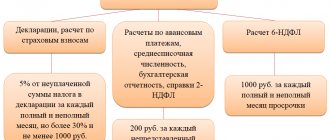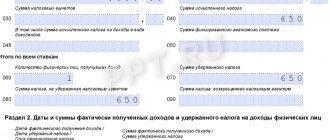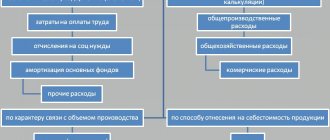The difference between an advance and a deposit
An advance is often confused with a deposit. Both the advance and the deposit have one function - advance payment for a product or service, partial or full. There is no clear definition in the legislation to separate these concepts, but according to established practice, an advance payment is considered to be the amount of prepayment for the transfer of which a separate agreement to the contract has not been drawn up:
Advances issued
An advance payment is an advance payment to the supplier against future deliveries, work performed or services performed. Transferring an advance payment to a supplier does not mean receiving economic benefits, since the supplier may, for various reasons, fail to fulfill its obligations under the contract: fail to ship goods, fail to provide a service. In this case, the advance payment is returned to the buyer’s account if it was transferred through a bank, or to the cashier if received in cash.
In general, there is no obligation to return the deposit from the supplier.
To account for VAT on advances in the chart of accounts, there is a subaccount on account 76, most often its code is 76.AB.
The buyer can accept VAT as a deduction only if the following conditions are met:
- Presence of an advance payment clause in the contract;
- Documents confirming the transfer of prepayment;
- The supply of goods (services, etc.) is intended for use in activities subject to VAT;
- Availability of a supplier's SF with a dedicated tax.
The buyer does not have the right to accept VAT as a deduction if all of the above conditions are not met. Acceptance of VAT deduction is not an obligation, but a right of the purchasing organization.
If an organization decides to use VAT deduction from an advance issued, then after the provision of the service and the closing of this advance, it will be obliged to restore this VAT to the budget.
Example
Let's say Altavista LLC transfers an advance in the amount of 23,600 rubles. (including VAT). Then Altavista LLC receives goods worth RUB 23,600 from this supplier.
The rate and amount of incoming VAT are indicated in the supplier's invoice.
Advances issued - postings
| Dt | CT | Operation description | Sum | Document |
| 60.2 | 51 | Transfer of advance payment | 23 600 | Payment order ref. |
| 19 | 60.2 | VAT on advance | 3 600 | Advance invoice (received) |
| 68 | 76(advances) | VAT deduction from advance payment | 3 600 | Book of purchases |
| 10 | 60.1 | The received goods are registered | 20 000 | Invoice |
| 19 | 60.1 | Incoming VAT reflected | 3 600 | SF supplier |
| 60.1 | 60.2 | Advance offset | 23 600 | Accounting information |
| 60.2 | 68 | Recovered VAT from advance payment | 3 600 | Sales book |
Accounting entries for advances from customers and suppliers
At the same time, the group of articles “Accounts receivable” is contained in the “Current assets” section.
In addition, it should be noted that according to paragraph 6 of PBU 4/99, financial statements must give a reliable and complete picture of the financial position of the organization, the financial results of its activities and changes in its financial position. Financial statements prepared on the basis of the rules established by regulatory acts on accounting are considered reliable and complete.
.
If, when preparing financial statements based on the rules of this Regulation
the organization
identifies insufficient
data to form a complete picture of the financial position of the organization, the financial results of its activities and changes in its financial position,
then the organization includes relevant additional indicators and explanations in the financial statements
.
Deviations from these rules can only be made in exceptional cases (for example, nationalization of property).
Also, in accordance with paragraph 73 of the Regulations on accounting and financial reporting in the Russian Federation, settlements with debtors
and creditors
are reflected by each party in its financial statements in the amounts arising from the accounting records and recognized by it as correct
.
Based on the above paragraph 19 of PBU 4/99, the classification of receivables into long-term and short-term is carried out on the basis of the maturity of such debt (i.e., in this particular case, the delivery time of the corresponding object), and not the operating life of the asset with the acquisition of which related to the transfer of the advance.
Thus, the position expressed in the letters of the Ministry of Finance of the Russian Federation under consideration is not regulated by regulatory documents on accounting in the Russian Federation; moreover, it currently contradicts them.
Taking into account the above, due to the fact that at present there is no direct prohibition on reflecting the advances in question as part of the group of items “Receivables”, advances, in our opinion, should be reflected in line 1230 “Receivables”
.
In our opinion, the procedure for presenting such advances in the balance sheet should be determined in the accounting policy.
At the same time, in the explanatory note and in the notes to the balance sheet, the Organization may provide more detailed information about the specific composition of the relevant assets (accounts receivable).
Board of Tax Consultants November 26, 2015
Accounting Regulations “Accounting Statements of an Organization” PBU 4/99, approved by Order of the Ministry of Finance of the Russian Federation dated 07/06/99 No. 43n.
“Recommendations for audit organizations, individual auditors, and auditors for conducting an audit of the annual financial statements of organizations for 2010.”
Order of the Ministry of Finance of the Russian Federation dated July 29, 1998 No. 34n
At the same time, in accordance with paragraph 19 of PBU 4/99, it is advisable to distinguish long-term and short-term receivables in this group.
This is interesting: Termination of LLC activities without liquidation
Disclosure of information about the nature of receivables is usually carried out by introducing additional lines, for example “including long-term” and “including short-term”.
Advances received
When an organization sells goods, works or services, the buyer can make an advance payment before the moment of sale.
According to the requirements of the Tax Code, the seller is obliged to charge VAT on the advance received. VAT is calculated using the formula:
VAT on the advance received = Sales amount *18/100
Example
Let's consider the previous example from the point of view of the selling organization, that is. VAT is charged on the advance payment at the time of its receipt; the amount of such VAT is reimbursed to the budget at the end of the tax period - quarter.
VAT on sales is accrued at the time of shipment, that is, at the time the sales transaction is created Dt 62 - Kt 90.1 .
Advances received - postings
When receiving an advance from a buyer, the accountant makes the following entries:
| Dt | CT | Operation description | Sum | Document |
| 51 | 62.2 | Advance received from buyer (including VAT) | 23 600 | Payment order in. |
| 76(advances) | 68 | VAT accrual on advance payment | 3 600 | Invoice issued, accounting certificate |
| 62.1 | 90.1 | Sales revenue accrued | 23 600 | Sales certificate, invoice |
| 90(VAT) | 68 | VAT on sales | 3 600 | SF issued, accounting certificate |
| 68 | 76(advances) | Accepted for deduction of VAT on advances (after sale) | 3 600 | Book of purchases |
How is VAT reflected in the balance sheet?
First, let's deal with the prepayment received from the store. According to the rules of the Tax Code, an organization on OSNO that is not exempt from VAT, when receiving an advance on account of upcoming deliveries of products, works, services upon receipt of them, must calculate VAT (clause 2, clause 1, Article 167 of the Tax Code). Let's do this:
At the moment when the clothes are sewn and shipped to Fashion LLC, VAT must be charged again - already on the cost of the shipped products:
And VAT accrued earlier on the advance payment is accepted for deduction (clause 1, clause 1 and clause 14 of Article 167, clause 8 of Article 171 and clause 6 of Article 172 of the Tax Code).
A deduction is made if, after receiving an advance payment, the terms of the contract are changed or terminated and the corresponding amounts of advance payments are returned (clause 5 of Art.
But in our example, we have only received an advance. How to reflect its receipt and VAT calculation in accounting? To do this, they usually use one of the subaccounts to account 76:
We must transfer the accrued VAT to the budget. We also issue an invoice to our buyer within 5 days after receiving the advance payment.
If the agreement between LLC “Style” and LLC “Moda” specifies an advance payment, then our buyer can claim VAT for deduction by receiving an invoice from us.
In the situation with Tweed LLC, the buyer is already Style LLC. And here the situation will be mirrored. We assume that the supplier is also on OSNO; upon receiving an advance payment from our organization, he charged VAT and issued us an invoice. The prepayment condition is specified in our contract.
We have the right (not obligated, but have the right, i.e. at will) to accept VAT on advance payment to the supplier for deduction (clause 12 of article 171 and clause 9 of article 172 of the Tax Code of the Russian Federation). In accounting, a special account is also used for these purposes. Because account 19 can only be used for purchased values.
In the future, when we receive fabrics from the supplier, we will deduct another VAT - on the purchased values. And VAT accrued on the advance payment will be deducted (clause 3, clause 3, article 170 of the Tax Code of the Russian Federation). It is for this reason that not everyone uses VAT deduction from the advance payment, so as not to clutter up the accounting.
Reflection of VAT on advances in the balance sheet
Continuing our example, let's assume that at the end of the year the fabric has not yet arrived from the supplier, and therefore there is no shipment of finished goods either. What account balances do we have:
At the end of the year, we need to show accounts receivable and payable in the balance sheet (we do not look at settlements with the budget). But how?
This can be done in 2 ways:
- VAT is allocated as separate lines and is not balanced:
In the balance sheet we see in this case the debt of the buyer to the supplier along with VAT.
In the balance sheet in this case we see the buyer’s debt to the supplier without VAT. There is a “winding down” of advances and VAT related to them, and due to this there will be a decrease in the balance sheet currency.
So which option is right?
Position of the Ministry of Finance
What is the basis for the officials' opinion?
PBU 1/2008 – assumption of going concern. Repayment of the obligation of the party who received the advance consists of the delivery of goods, performance of work, and provision of services. And based on the requirements of tax legislation, in terms of payment and reimbursement of VAT, the amount of obligations to be repaid does not include the amount of VAT.
There is a certain logic in the position of officials. The advance received in the future turns into revenue, which is reflected in the financial results statement without VAT. It would be logical if this “future” revenue would also be shown in the same estimate.
Similarly, the advance payment will later turn into materials, goods, services, and work, which will be reflected in the balance sheet without taking into account refundable VAT.
This is interesting: Time frame for replacing a passport by age 45
Another opinion
Supporters of option No. 1 have their own justifications:
— in the financial statements, offsets between items of assets and liabilities, items of profits and losses are not allowed, except in cases where such offset is provided for by the relevant PBUs (clause 34);
— the rules for evaluating individual items of financial statements are established by the relevant accounting provisions (clause 36);
For our situation, no rules of offset and evaluation are established in any PBU. VAT on advances is not a regulating value.
— items in the financial statements prepared for the reporting year must be confirmed by the results of the inventory of assets and liabilities (clause 38). The reconciliation with counterparties, of course, includes the entire amount of debt including VAT.
- Clause 73 Provisions for accounting and financial reporting: each party must show the amounts that follow from the accounting records and are recognized by it as correct. In the accounting records for accounts 60-2 and 62-2, we have the full amount of debt, including VAT.
- From the point of view of the Civil Code, the debt of the organization that received the advance exists in full. And upon termination of the contract, the refund will also be in full, including VAT.
Therefore, in practice, the decision will have to be made by the accountant, based on his professional judgment. In any case, the selected option must be included as a disclaimer in the explanations provided with the reporting. Program 1C: Accounting implements option No. 2, i.e. balances the balances.
Read Full Article








